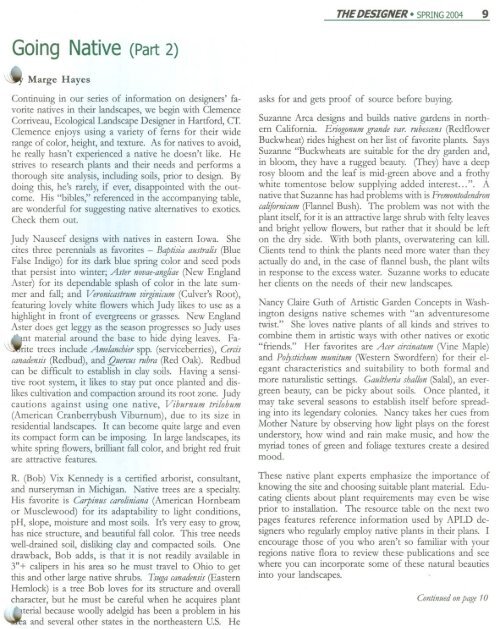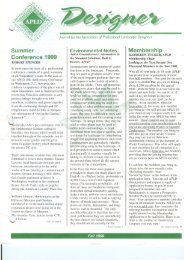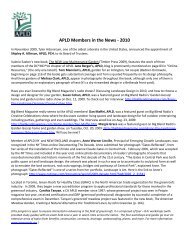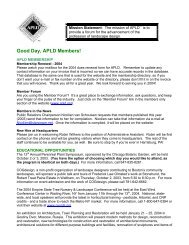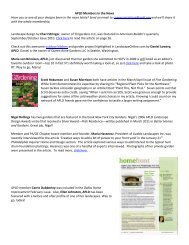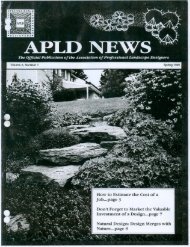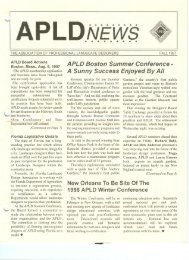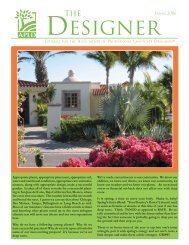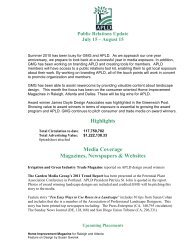ESIGNER - Association of Professional Landscape Designers
ESIGNER - Association of Professional Landscape Designers
ESIGNER - Association of Professional Landscape Designers
You also want an ePaper? Increase the reach of your titles
YUMPU automatically turns print PDFs into web optimized ePapers that Google loves.
THED<strong>ESIGNER</strong>. SPRING 2004 9<br />
Going Native (Part 2)<br />
Marge Hayes<br />
Continuing in our series <strong>of</strong> information on designers' favorite<br />
natives in their landscapes, we begin with Clemence<br />
Corriveau, Ecological <strong>Landscape</strong> Designer in Hartford, CT.<br />
Clemence enjoys using a variety <strong>of</strong> ferns for their wide<br />
range <strong>of</strong> color, height, and texture. As for natives to avoid,<br />
he really hasn't experienced a native he doesn't like. He<br />
strives to research plants and their needs and performs a<br />
thorough site analysis, including soils, prior to design. By<br />
doing this, he's rarely, if ever, disappointed with the outcome.<br />
His "bibles," referenced in the accompanying table,<br />
are wonderful for suggesting native alternatives to exotics.<br />
Check them out.<br />
Judy Nauseef designs with natives in eastern Iowa. She<br />
cites three perennials as favorites - Baptisia australis (Blue<br />
False Indigo) for its dark blue spring color and seed pods<br />
that persist into winter; Aster novae-angliae (New England<br />
Aster) for its dependable splash <strong>of</strong> color in the late summer<br />
and fall; and Veronicastrum virginicum (Culver's Root),<br />
featuring lovely white flowers which Judy likes to use as a<br />
highlight in front <strong>of</strong> evergreens or grasses. New England<br />
Aster does get leggy as the season progresses so Judy uses<br />
nt material around the base to hide dying leaves. Farite<br />
trees include Amelanchier spp. (serviceberries), Cereis<br />
canadensis (Redbud), and Quercus rubra (Red Oak). Redbud<br />
can be difficult to establish in clay soils. Having a sensitive<br />
root system, it likes to stay put once planted and dislikes<br />
cultivation and compaction around its root zone. Judy<br />
cautions against using one native, Viburnum trilobum<br />
(American Cranberrybush Viburnum), due to its size in<br />
residential landscapes. It can become quite large and even<br />
its compact form can be imposing. In large landscapes, its<br />
white spring flowers, brilliant fall color, and bright red fruit<br />
are attractive features.<br />
R. (Bob) Vix Kennedy is a certified arborist, consultant,<br />
and nurseryman in Michigan. Native trees are a specialty.<br />
His favorite is Carpinus caroliniana (American Hornbeam<br />
or Musclewood) for its adaptability to light conditions,<br />
pH, slope, moisture and most soils. It's very easy to grO\v,<br />
has nice structure, and beautiful fall color. This tree needs<br />
well-drained soil, disliking clay and compacted soils. One<br />
drawback, Bob adds, is that it is not readily available in<br />
3"+ calipers in his area so he must travel to Ohio to get<br />
this and other large native shrubs. Tsuga canadensis (Eastern<br />
Hemlock) is a tree Bob loves for its structure and overall<br />
character, but he must be careful when he acquires plant<br />
terial because woolly adelgid has been a problem in his<br />
a and several other states in the northeastern U.S. He<br />
asks for and gets pro<strong>of</strong><br />
<strong>of</strong> source before buying.<br />
Suzanne Arca designs and builds native gardens in northern<br />
California. Eriogonum grande var. rubescens (Red flower<br />
Buckwheat) rides highest on her list <strong>of</strong> favorite plants. Says<br />
Suzanne "Buckwheats are suitable for the dry garden and,<br />
in bloom, they have a rugged beauty. (They) have a deep<br />
rosy bloom and the leaf is mid-green above and a frothy<br />
white tomentose below supplying added interest ... ". A<br />
native that Suzanne has had problems with is Fremontodendron<br />
californicum (Flannel Bush). The problem was not with the<br />
plant itself, for it is an attractive large shrub with felty leaves<br />
and bright yellow flowers, but rather that it should be left<br />
on the dry side. With both plants, overwatering can kill.<br />
Clients tend to think the plants need more water than they<br />
actually do and, in the case <strong>of</strong> flannel bush, the plant wilts<br />
in response to the excess water. Suzanne works to educate<br />
her clients on the needs <strong>of</strong> their new landscapes.<br />
Nancy Claire Guth <strong>of</strong> Artistic Garden Concepts in Washington<br />
designs native schemes with "an adventuresome<br />
twist." She loves native plants <strong>of</strong> all kinds and strives to<br />
combine them in artistic ways with other natives or exotic<br />
"friends." Her favorites are Acer eireinatum (Vine Maple)<br />
and P<strong>of</strong>ystichum munitum (Western Swordfern) for their elegant<br />
characteristics and suitability to both formal and<br />
more naturalistic settings. Gaultheria shallon (Salal), an evergreen<br />
beauty, can be picky about soils. Once planted, it<br />
may take several seasons to establish itself before spreading<br />
into its legendary colonies. Nancy takes her cues from<br />
Mother Nature by observing how light plays on the forest<br />
understory, how wind and rain make music, and how the<br />
myriad tones <strong>of</strong> green and foliage textures create a desired<br />
mood.<br />
These native plant experts emphasize the importance <strong>of</strong><br />
knowing the site and choosing suitable plant material. Educating<br />
clients about plant requirements may even be wise<br />
prior to installation. The resource table on the next two<br />
pages features reference information used by APLD designers<br />
who regularly employ native plants in their plans. I<br />
encourage those <strong>of</strong> you who aren't so familiar with your<br />
regions native flora to review these- publications and see<br />
where you can incorporate some <strong>of</strong> these natural beauties<br />
into your landscapes.<br />
Continued on page 10


